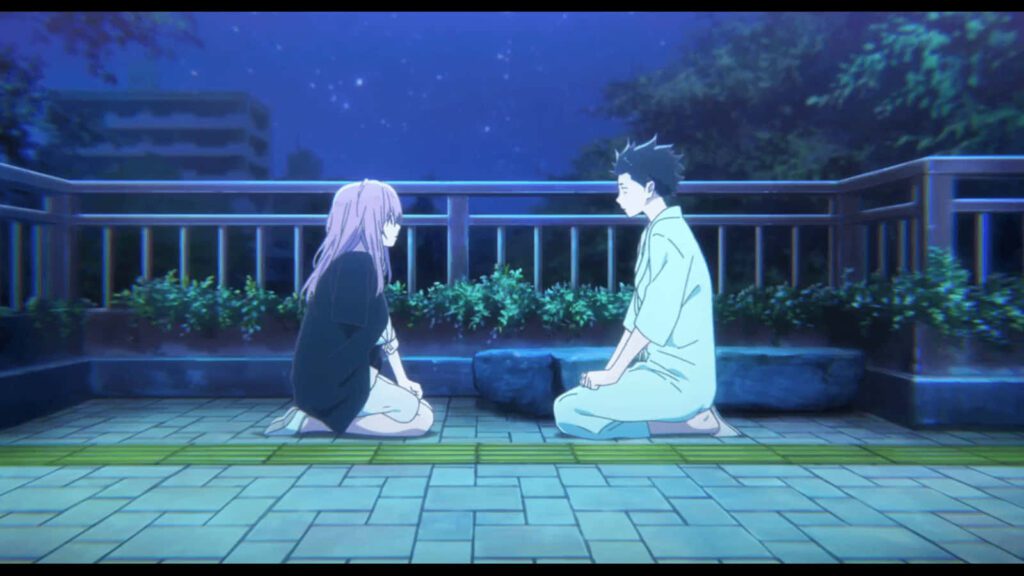Ryan Xia
San Francisco, California, United States

During the COVID-19 pandemic, deaths from suicide surged as social isolation disrupted daily routine and promoted feelings of loneliness and anxiety.1 The pandemic shed light on risk factors that increase one’s likelihood of committing suicide,2 such as the loss of a loved one or the loneliness of being isolated from society. Individuals ill-prepared to face these challenges would be at risk, as evident in the direct correlation between the pandemic and suicide rates.1
The film Koe no Katachi (A Silent Voice) (2016) directed by Naoko Yamada, an adaptation of the manga written by Yoshitoki Ōima, explores the topic of suicide through the story of its two protagonists: Shoko Nishimiya—a victim of extensive bullying—and Shoya Ishida, her bully. As a child with hearing disabilities, Shoko was somewhat of a social outcast, often bullied by her classmates, most notably by Shoya. During her teenage years, Shoko underwent waves of deep depression, leading to her suicide attempt. As Shoya’s friends realized the monster he was, targeting a helpless girl, they began to cast him aside. While he became guilt-ridden for his childhood actions and contemplated suicide to atone for his sins, he decided instead to reconcile with Shoko. In the end, he redeems himself by saving Shoko from suicide and redirects himself away from suicidal ideation by recognizing many protective elements in his life.
Shoko presents a typical case of a suicide victim, her self-esteem worsening dramatically, leading to an overall degradation of her psyche. The filmmakers emphasized pivotal moments to demonstrate the reason for Shoko’s low self-esteem in her formative years, notably the traumatic bullying she underwent in grade school. The ramifications of a low self-esteem are often embodied in depressive and anxious tendencies,3 evident in Shoko’s state of mind after her childhood: “If you’re going to kill yourself, do it quickly. It’s a painless way to die, and you won’t have to see the disappointed looks on everyone’s faces.” She assumes everyone will be disappointed by her decision to kill herself. Her environment at home is also lackluster. Her mother abandoned the notion of raising Shoko after she was born, and her grandmother died during her teenage years. With no supportive family except for her sister, she was left to grapple with her own woes to no avail.
Shoya’s story differs from Shoko’s by the addition of suicidal protective factors, one of which is friendship. He was able to break his many friendless years by befriending Tomohiro Nagatsuka. Saving Tomohiro from a bike thief, Shoya was seen by Tomohiro in a positive light. He was the first person Shoya could truly confide in with ill-regard to his past self; he was the first person he could feel confident conversing with without harboring guilt. His new friend symbolized a step ahead into the brighter future, a future past the negativity associated with his current self. In this sense, Tomohiro illustrates the power of suicidal protective factors in aiding those who have endured mental pain.
Ironically, Shoko is another protective factor for Shoya. While the notion of saving her does not necessarily bring contentment as per definition of a protective factor, it gives Shoya a sense of purpose and later of self-fulfillment. Because of this, Shoko represents the predominant factor underlying Shoya’s psyche that deters him from suicide, solely defining why Shoya chose to live rather than to die.
By analyzing the conditions of Shoya and Shoko throughout A Silent Voice, we can better understand how risk and protective factors may exacerbate or mitigate suicide risk. For Shoya, being cast away from society because of his childhood personality struck as a decisive risk factor. However, he managed to regain mental health through his redemption journey regarding Shoko. On this journey, he gained many other protective factors, effectively counteracting any self-destructive tendencies. Conversely, it was the near absence of protective factors from Shoko’s life accompanied by a surplus of risk factors that induced her suicide attempt. Her classmates’ alienation towards her throughout her formative years set the stage for her psyche to continue worsening into her teenage years. Her ill-fated home life only exacerbated the situation. The contrast is clear between the two characters regarding the presence versus the absence of suicidal protective factors.
In the post-pandemic world where a multitude of protective factors have been lost, including social contact, loved ones, and income, the importance of seeking therapists and psychiatrists cannot be understated. Despite this, therapy is often stigmatized in the general public and workplace. The message of A Silent Voice is clear: our mental health is as relevant as our physical health; the introduction of protective factors to remedy mental pain is crucial to protecting more lives.
References
- Pathirathna, Malshani, Hapugahapitiye Mohottalage Renu Kalhari Geethani Nandasena, Atapattu Mudiyanselage Muditha Piumali Atapattu, and Ishanka Weerasekara. “Impact of the COVID-19 Pandemic on Suicidal Attempts and Death Rates: A Systematic Review – BMC Psychiatry.” BioMed Central, July 28, 2022. https://bmcpsychiatry.biomedcentral.com/articles/10.1186/s12888-022-04158-w.
- “Risk and Protective Factors.” Centers for Disease Control and Prevention, November 2, 2022. https://www.cdc.gov/suicide/factors/index.html.
- “Self-Esteem.” Psychology Today. Accessed April 19, 2024. https://www.psychologytoday.com/us/basics/self-esteem.
RYAN XIA is an honors high school student with multiple awards in piano performance. He is fascinated by the sciences and humanities and intends on entering the field of electrical engineering. He enjoys watching anime in his spare time and explores portrayals of mental health crises in modern media.

Leave a Reply